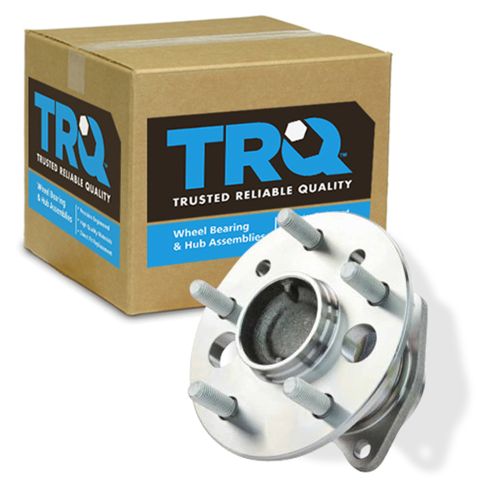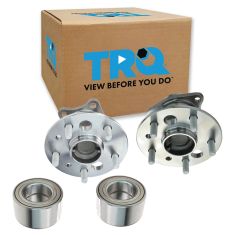1ASFK00079-Toyota Lexus Rear Driver & Passenger Side 2 Piece Wheel Bearing & Hub Assembly Set TRQ BHA53296

Replaces
2004 Lexus ES330 Rear Driver & Passenger Side 2 Piece Wheel Bearing & Hub Assembly Set TRQ BHA53296

Product Reviews
Loading reviews
5.00/ 5.0
30
30 reviews
Toyota bearings
March 13, 2017
Quick delivery. Bearings working fine. Good value, if they last.
Correct parts
August 21, 2018
Order was a little late , but 1A Auto stayed with the purchase and my questions thru to delivery, to ensure transaction was successful. AL
Great value, perfect fit
June 21, 2019
I purchased the hub assembly for my 2009 Camry. I had no problem installing it. Perfect fit and quiet as the original one. Just make sure you disconnect the ABS sensor before removing the old one so you don't damage the connector. 1A Auto is becoming a go to place for parts in my list. Nobody beats their prices for great quality.
July 29, 2019
It was my first time purchasing anything from u . Enjoyed the free shipping. And the YouTube u can refer to. I did have a concerned about the part number. It didn't match my invoice. So I call customer service and the assured me that the part would fit. And it did. Rock Auto has more parts and more venders. All in all I was very satisfied.
September 11, 2019
Thank you
Hub and wheel bearing assembly
October 1, 2019
Great product my 2008 Toyota Camry running smooth. Recommend this product a 100% to others interested in buying this product.
Thank
Works great and easy to install
October 7, 2019
The item was exactly as advertised and is working great.
Aldo mech.
February 27, 2020
It fixed my problem and the price for the pair was great, easy to change but don't need to disassemble the parking brake like the video suggested. Lets see how long they last?
Great Parts
March 8, 2020
Great Parts, Great Prices & Fast Shipping.
Very good quality
August 2, 2020
The product is equivalent to OEM at a great price.
great job
June 29, 2021
So much survey i can only say the same thing, good job 1A
Would recommend
July 3, 2021
Works great easy install!! Fixed the noise coming from the rear! Would recommend!
August 27, 2021
Easy to install. Good quality!
Smooth and quiet
October 1, 2021
Great product. Car rides super smooth with no wheel noise
Best product ever!!!!
October 12, 2021
Best price available with a great quality always buy it from 1aauto
The part
November 26, 2021
I love you all parts
December 21, 2021
working fine
Perfect
January 12, 2022
Perfect fit for 2007 Toyota Camry LE and a great price!
On time Packaging was an excellent condition
June 25, 2022
Shipping was great packaging was excellent conditions of the product was awesome .
Excellent
December 12, 2022
Excellent. Bearing already pressed into.
Slap it and go
Easy and inexpensive rear hub changeout.
January 10, 2023
Easy installation and totally eliminated the loud roar coming from my 2007 Toyota Camry LE rear wheels.
Wheel bearing Fixture
January 17, 2024
Easy to install and DIY videos help a lot. Appreciate the help 1AAUTO
No.roar rumble sound
January 26, 2024
Smooth ride and super quiet! Made a huge difference. Rears were worn. It's a joy to drive!
camry bearings
February 4, 2024
good quality parts, fair price fasr shipping! :)
Fit perfect
February 20, 2024
These fit my grandsons car and were not to bad to change. Did have to use a piece of 4x4 and a hammer to knock old one off. Great fit on an 2004 Camry.
Appears to be good quality
March 2, 2024
Fit, finish and function appears to be of qood quality. Installed easily. Have not used it much to date, but based on current experience would recommend this product and would purchase the same again if needed.
Great quality parts.
[{"url": "https://wac.edgecastcdn.net/001A39/prod/media/pNISJll75W64CYGsite/e2c28f21e9e3ea11c67131bafd576293_1712643522270_0.jpeg", "caption": ""}, {"url": "https://wac.edgecastcdn.net/001A39/prod/media/pNISJll75W64CYGsite/55a578483912a06e99272d4fd0336f03_1712643522270_1.jpeg", "caption": ""}, {"url": "https://wac.edgecastcdn.net/001A39/prod/media/pNISJll75W64CYGsite/9fad33790de5da5548fb8212894cacb8_1712643522270_2.jpeg", "caption": ""}]
April 9, 2024
These hub assemblies are very good. Great quality like always! No more humming sound coming from the rear wheel of my 2011 Toyota Camry LE.
Thanks 1A Auto!
W product
April 20, 2024
Came in quick and put on simple no complaints
June 27, 2024
Great parts at a very good price.
September 16, 2024
All parts have checked out ok. Video was very helpful.
Customer Q&A
Is black part in the picture of the paint the brake sensor?
February 25, 2016
10
Yes there's a sensor on it, work great. Unplug the sensor first before tearing it apart
February 25, 2016
Joe S
10
Yes
February 25, 2016
Roe R
10
That is the back cover and the connector for the wheel speed sensor
February 25, 2016
Art W
10
Yes
February 25, 2016
Brian F
10
Yes
February 25, 2016
Tyler R
10
Yes it is abs sensor.
March 15, 2016
David B
Is the black part in the picture of the pair the brake sensor?
February 25, 2016
10
Yes the abs sensors
February 25, 2016
Rick P
10
Yes the ABS is built in. Just plug in your harness.
February 25, 2016
Brian F
10
Be careful not to damage the abs sensor connection in the back.
August 16, 2016
Thai X
Are these brand new?
April 2, 2016
10
Yeah, they are new and really good. I have put almost 40k miles on them, no issues.
April 2, 2016
Balixa, harry b N
10
YES
April 3, 2016
Thomas A Campbell N
10
I purchased these bearing in 2014 have put on over 1600 miles on them , they were new as far as I am concerned
April 3, 2016
Dennis D
10
yes these are new
April 4, 2016
Brian F
10
Yes they are.
April 5, 2016
David B
Do these have to be pressed?
November 14, 2017
10
No, once the brake calipers are un-bolted, and the old bearing removed, they can be bolted right on into the axle.
November 14, 2017
Douglas V
10
No. but to take the old one out was a bit difficult.
November 14, 2017
Seng S
10
Front have to be pressed. Rears just bolt on.
November 14, 2017
Robert C
10
No, they are bolt on. You better have a torch handy, the bearings get rusted onEnter
November 14, 2017
Gary B
10
No. These come fully assembled. Reccomend you also purchase new lug nuts with fresh threads. You'll probably also need a breaker bar to get your old assemblies off, and reinstall with sufficient torque. I'd also pick up a metal hammer and pb blaster to get the old ones loose. Installed these on a 2008 Camry and they fit perfect. Take your time.
November 14, 2017
Daniel F
10
These are simple bolt on replacements.
November 14, 2017
Alex P
03 camry rear hubs come right and left hand because of the abs ?
May 27, 2019
10
These are correct for the rear wheels of a 2003 Camry with ABS, they will not be correct for models without ABS. We do offer them in a pair at this link: https://www.1aauto.com/wheel-bearing-and-hub-assembly-pair-trq-bha53296/i/1asfk00079?f=351638&y=2003
May 27, 2019
A C
what ft/lbs of torque did you use for the hub assembly?
June 24, 2021
10
Written and video installation instructions are found on the product page under the "How-To & Tools" tab if available. We're constantly adding new installation video instructions. If we do not have one for your vehicle on the product listing page, please check again at a later time or check our Video Library to see similar repairs here: https://www.1aauto.com/videos
June 24, 2021
Adam G
10
I press the hub until it meets the bearing. Never have to torque it. It is as tight smooth spin is how i do it.
June 30, 2021
Thai X
Would this work for a AWD 2001 highlander?
May 16, 2022
10
This is not the correct part for your vehicle, but we do carry the one you need. The correct part number is: BHA53279
May 16, 2022
Cristina P
Dose the wheel bearing and hub comes already assembled together?
May 27, 2022
10
Yes, it will come preassembled as shown in the listing image!
May 27, 2022
Andra M
Is this for the 3.5 V6 Camry?
November 28, 2022
10
I need some more information to determine if this will fit.
What is the year of the Camry?
Does it have abs brakes?
November 29, 2022
Kelly S
How are these holding up after 10K, 20K miles. Any issues?
April 17, 2023
10
Not very well I'm fixing to put the ones that I had back on there cuz I was if it's cool as our cold in the mornings it'll start skipping and don't run right until it warms up
May 2, 2023
Michael M
Lexus is a registered trademark of Toyota Motor Corporation. 1A Auto is not affiliated with or sponsored by Lexus or Toyota Motor Corporation.
See all trademarks.












